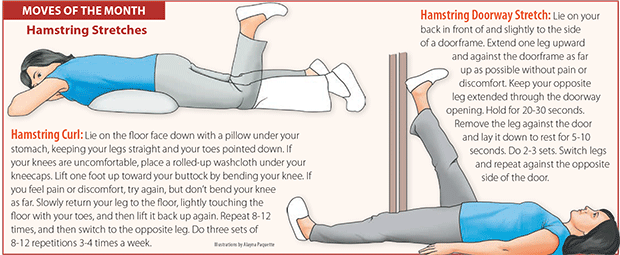Protect Your Hamstring Muscles and They Will Protect You
Your hamstring—a group of three muscles which run down the back of your thigh from your hip to your knee—plays a major role in supporting your hips, legs, knees, and back. Hamstrings help us conduct movements such as standing up from a sitting position, walking, lifting from a squat position, and standing in one place for any length of time (such as a grocery store line). Damage to your hamstring could result in additional damage to the bones, muscles, and tissues it supports.
One common problem that causes hamstring injuries is trying to stretch or do a strenuous exercise without properly warming it up, such as in yoga, Zumba, running, or squatting. “It’s important to ensure that you never stretch any muscle when it’s cold—you should always warm it up first,” says Aaron Karp, an exercise physiologist at the Hospital for Special Surgery, an affiliate of Weill Cornell Medicine.
Walking is a great warm-up exercise because you can start out slowly and increase gradually. Ten to 15 minutes is a reasonable amount of time to warm up your hamstrings. Cardio exercises, which increase your heart rate, also are good for warming up all muscles. “A few minutes on a bike or elliptical will improve blood circulation and warm up the muscle, making it more pliable so it is prepped for stretching,” says Karp.
Prior to taking an exercise class such as yoga or Zumba, warm your muscles for at least 15 minutes. Once you have warmed up, “you can start stretching your hamstring gradually until you feel a comfortable stretch in the back of your thigh,” Karp says. “You don’t need to force the muscle beyond this point.”
Signs of a Hamstring Injury
You’ll know if you’ve pulled a hamstring by sudden severe pain behind the upper leg or buttock, muscle spasms, bruising and tenderness, and possibly swelling, Karp explains. He suggests rest, ice applications, elevation, and compression wraps as the first line of treatment. Aspirin, acetaminophen, ibuprofen, and naproxen may relieve the pain.
“Some soreness after exercise is normal,” Karp says. “However, if you feel any sudden sharp pain or deep aching for several days, you may want to consult a qualified professional.”
Wearing heels will change the normal alignment of your body, which can affect your hamstring. Consider how long you stand in heels on a daily basis. If your activities of daily living require wearing heels, you may need to spend a larger portion of your exercise routine working on your hamstrings.
Leg Machines at the Gym
“I recommend staying away from machines at the gym,” says Karp. “Free weights or even body weight alone are generally better. If you must use a hamstring curl machine, start with a lighter weight and build gradually.” Since most hamstring injuries occur during the eccentric phase (when the muscle is lengthening), it would be beneficial to improve strength in this phase of motion. Start with a light weight, Karp says. Perform a hamstring curl, then slowly straighten your knee for roughly four seconds.

The post Protect Your Hamstring Muscles and They Will Protect You appeared first on University Health News.
Read Original Article: Protect Your Hamstring Muscles and They Will Protect You »
Powered by WPeMatico

